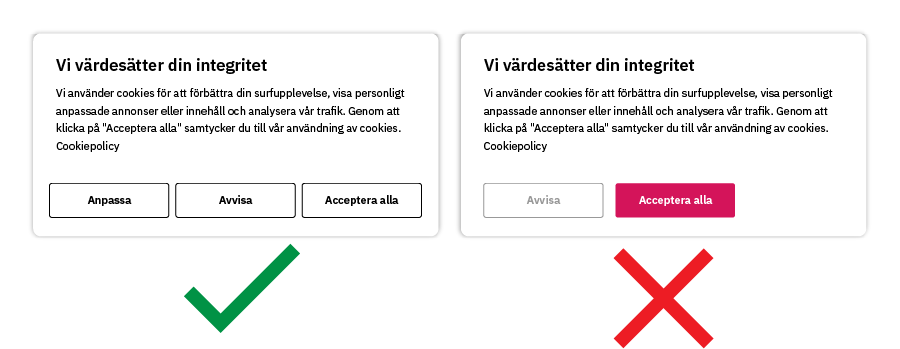When I surf the web these days, I almost instinctively click the ‘Accept all’ button in the cookie banner as soon as I see it. But there’s more to that little button than meets the eye. Tracking, data sharing – and often outright mistakes in how it’s set up.
It is quite common for websites today to collect data without valid consent. Approximately 80% of all cookie banners are incorrectly designed, both in terms of design and fair choices. It also happens that the same event is measured twice on a website, or that your personal data is sent in plain text – that is, without being anonymised. So I feel it is a good idea to write down some important points to consider regarding cookie banners. Everything from how they should look to how they should handle data collection.
What should a cookie banner look like?

- All buttons should be equally eye-catching and should not be highlighted more than other options.
- No data should be collected before you click the accept button.
- The user should have access to customise which cookies the website is allowed to store.
- Consent should be easy to check afterwards.
- A link to the website’s privacy policy should be easy to find.
- Analytical tools should not be set as necessary cookies for the website to function.
Consent Mode
Consent Mode controls what can be tracked based on your choices. If you accept cookies on the website, data is collected as usual. If you decline cookies, only small, so-called ‘cookie-less signals’ are sent. These are anonymous signals that do not identify personal data, for example to provide a general overview of user behaviour on the website.
Many people believe that they are following the rules regarding Consent Mode, but if these track more than they are allowed to, then Consent Mode is not set up correctly.
Third-party cookies
Third-party cookies are on their way out. When third-party cookies disappear, companies will have to start collecting data in a more transparent and respectful way.
This means that you can no longer rely on ‘background tracking,’ but need to build your own first-party data – information you get directly from visitors who have actually chosen to share it.
In summary
In short: If you want to do the right thing – both legally and ethically – start with the simple stuff:
- Ensure that your cookie banner is correctly designed in terms of layout, function and information.
- Check that nothing is tracked before consent has been given by the visitor.
- Follow up regularly to ensure that your Consent Mode is working as intended.
This may be a bit of a cliché, but when you demonstrate that you take people’s privacy seriously, including digital privacy, you also build trust, which is worth more than all the data in the world.
And of course, if you have any questions or need help with your website, we are happy to assist!



